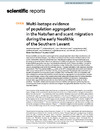Please use this identifier to cite or link to this item:
https://accedacris.ulpgc.es/handle/10553/107552
| Title: | Multi-isotope evidence of population aggregation in the Natufian and scant migration during the early Neolithic of the Southern Levant | Authors: | Santana Cabrera, Jonathan Alberto Millard, Andrew Ibáñez-Estevez, Juan J. Bocquentin, Fanny Nowell, Geoffrey Peterkin, Joanne Macpherson, Colin Muñiz, Juan Anton, Marie Alrousan, Mohammad Kafafi, Zeidan |
UNESCO Clasification: | 550405 Prehistoria 2503 Geoquímica |
Issue Date: | 2021 | Journal: | Scientific Reports | Abstract: | Human mobility and migration are thought to have played essential roles in the consolidation and expansion of sedentary villages, long-distance exchanges and transmission of ideas and practices during the Neolithic transition of the Near East. Few isotopic studies of human remains dating to this early complex transition offer direct evidence of mobility and migration. The aim of this study is to identify first-generation non-local individuals from Natufian to Pre-Pottery Neolithic C periods to explore the scope of human mobility and migration during the Neolithic transition in the Southern Levant, an area that is central to this historical process. The study adopted a multi-approach resorting to strontium (87Sr/86Sr), oxygen (δ18OVSMOW) and carbon (δ13C) isotope ratio analyses of tooth enamel of 67 human individuals from five sites in Jordan, Syria, and Israel. The isotope ratios point both to a significant level of human migration and/or mobility in the Final Natufian which is compatible with early sedentarism and seasonal mobility and with population aggregation in early sedentary hamlets. The current findings, in turn, offer evidence that most individuals dating to the Pre-Pottery Neolithic were local to their respective settlements despite certain evidence of non-locals. Interestingly, isotopic data suggest that two possible non-local individuals benefitted from particular burial practices. The results underscore a decrease in human mobility and migration as farming became increasingly dominant among the subsistence strategies throughout the Neolithic transition of the Southern Levant. | URI: | https://accedacris.ulpgc.es/handle/10553/107552 | ISSN: | 2045-2322 | DOI: | 10.1038/s41598-021-90795-2 | Source: | Scientific Reports [EISSN 2045-2322], v. 11 (1), 11857, (Diciembre 2021) |
| Appears in Collections: | Artículos |
SCOPUSTM
Citations
12
checked on Jun 8, 2025
WEB OF SCIENCETM
Citations
9
checked on Jun 8, 2025
Page view(s)
81
checked on Jan 20, 2024
Download(s)
504
checked on Jan 20, 2024
Google ScholarTM
Check
Altmetric
Share
Export metadata
Items in accedaCRIS are protected by copyright, with all rights reserved, unless otherwise indicated.
